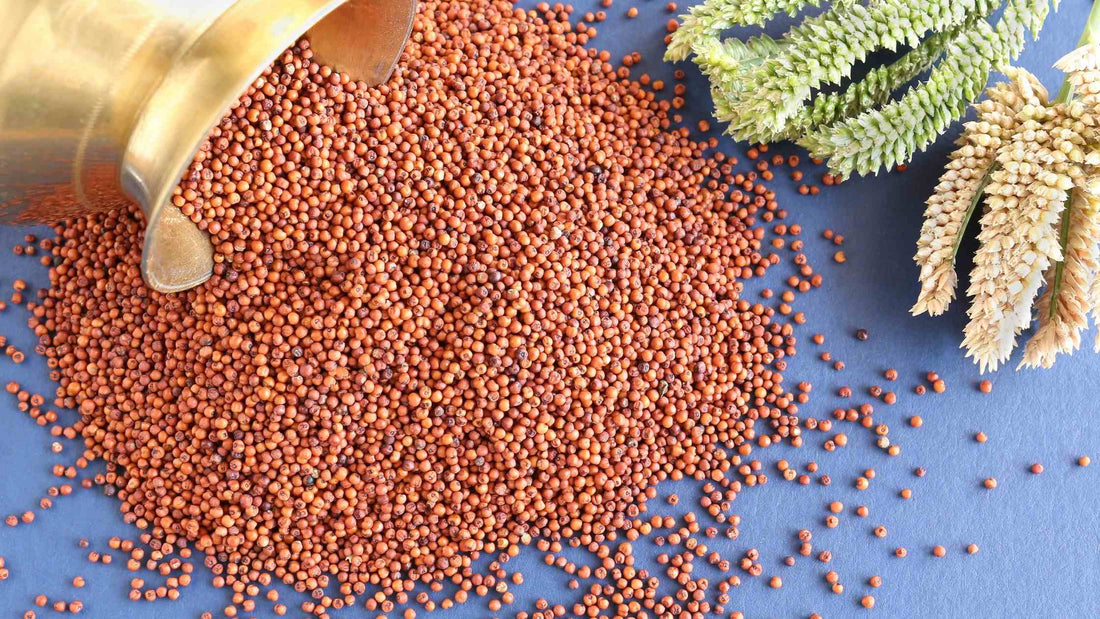
10 Health Benefits of Ragi
Naturally YoursShare

Ragi is a wonderful ingredient that was lost, as the popularity of wheat and rice grew.
This, one of the ancient forgotten millets, is slowly resurfacing as the latest DESI SUPERFOOD!
Ragi has different names in local languages. In India, finger millet is commonly called by various names like Ragi (Kannada, Hindi and Telugu), and also Mandua/ Mangal in Hindi, Kodra (Himachal Pradesh), Mandia (Oriya), Taidalu (Telangana), Nachni in Marathi.
Nutritional Value of the Ancient grain- Ragi
Ragi is loaded with a variety of macro and micronutrients, essential fats, proteins, vitamins and minerals.
All in all, Ragi can be easily termed as a superfood.
Nutritional value per 100gm
Calories- 354 kcal
Total fat- 3.4gm
Saturated fat- 0.7gm
Polyunsaturated Fat (PUFA) -2gm
Monounsaturated Fat (MUFA) – 0.7gm
Cholesterol- 0 mg
Sodium- 5mg
Potassium- 40mg
Carbohydrates- 80gm
Dietary fibre- 2.7gm
Sugars- 0.6gm
Protein- 13gm
Health Benefits of Ragi
Let’s have a look at how the Ragi nutrition content affects your body-
1. Rich in protein
Ragi is an excellent vegan source of protein. 100gms of Ragi provides 13gm of protein.
2. Rich in Calcium
100gms of Ragi is enough for fulfilling 49% of our body’s daily calcium needs. Along with calcium,4. Rich in Antioxidants
Ragi is loaded with antioxidants which help your body to fight against the free radicals and thus slow down the ageing process. Antioxidants also help reduce the risk of Cancer considerably.

5. Good for Diabetics
Ragi is rich in Magnesium content. Magnesium lowers our body’s insulin resistance and thus helps maintain blood sugar levels.
6. Gluten free
Ragi, being gluten free, is an excellent option for people with Gluten sensitive enteropathy or celiac disease. Also, it is a widely consumed grain for those who are fitness freaks or ones who are looking to make healthy food choices.
7. Great for Digestion
Ragi is rich in both soluble and insoluble fibre. This fibre helps keep us full for longer hours, thus relieving constipation.
8. Ragi helps in relaxing the body naturally. It is beneficial for conditions like blood pressure, anxiety, depression, migraines, liver disorders, asthma and heart weakness.
9. An excellent weaning food
Because of high nutritional content, Ragi is considered as an excellent weaning food. It is the first fed cereal to infants.
10. Good for hair
Ragi helps prevent hair loss. Ragi is also said to prevent pre mature greying of hair. This is usually caused due to oxidation of tissues, and the antioxidants present in
Ragi will effectively prevent the damage to tissues, thereby reducing grey hair possibility.
How to cook Ragi
Ragi really is so small that it cannot be polished all that much, means that it basically retains all the good stuff.
Ragi flour can be used in making chapatis, Bhakris, chilla, dosas, porridges, cakes, pancakes, parathas, cookies!!
Whole ragi can be used to make upma. Whole ragi is washed for a few seconds and excess water is removed and it is kept aside. This allows Ragi to absorb the remaining water and swell slightly.
Ragi can also be used to make malt. It is soaked for 12 hours. Then it is tied for 2-3 days, dried and the roots are removed. The grains are then dry roasted, ground to a fine powder and sieved.
A Simple Recipe: Ragi Dosa
1 cup ragi flour
½ cup rice flour or wheat flour
½ cup fine Rawa
1/4th cup curd
Water as required
Salt to taste
Finely cut green chilli
Ginger grated
Oil
Recipe-
1. Make a batter of all the above ingredients. Add little water if required.
2. Grease a non-stick pan well.
3. When the tawa is hot enough, pour the batter
4. Spread slowly and cook on medium heat.
5. Flip the side and cook the other side well.
6. Serve hot with mint or coriander chutney.
Summing up!
By simply looking at the health benefits of Ragi, wouldn’t it be fair to conclude it as a super food! Yes,
References
Rastogi et al. Effect of Ragi for the development of Value added products and their nutritional implication. Asian J Home Sci.10 (1) : 1-5
S Shobana et al. Adv Food Nutr Res. 2013. Finger millet (Ragi) : a review of its nutritional properties, processing, and plausible health benefits.
Padmaja Jagati, Indurekha Mahapatra et al. Finger millet (Ragi) as an essential dietary supplement with key health benefits : A Review.
Nutritive value of Indian Foods by C Gopalan et al.
Trending Articles
1) Amaranth : Health benefits and how to cook - Read Now
2) Millets for diabetes : A complete guide - Read Now
3) Kodo Millets : Nutrition, health benefits and recipes - Read Now
ABOUT THE AUTHOR

Sneha Jain, Dietician
Sneha is a Post graduate with specialization in Nutrition and Dietetics. She is a university topper and holds 5+ years of experience in Apollo hospitals, VLCC, slimsutra and first cry fit-kids .
She has successfully counselled clients all over India for weight loss, weight gain, diabetes, hypertension, PCOD, hypothyroid, Pregnancy and lactation and growth charts for children. She has her own diet consultation e-clinic (diet_diariez)
She believes in customized diets and eating local and seasonal foods. Her counselling not only involves diet planning, but also lifestyle modification and stress relief strategies.



